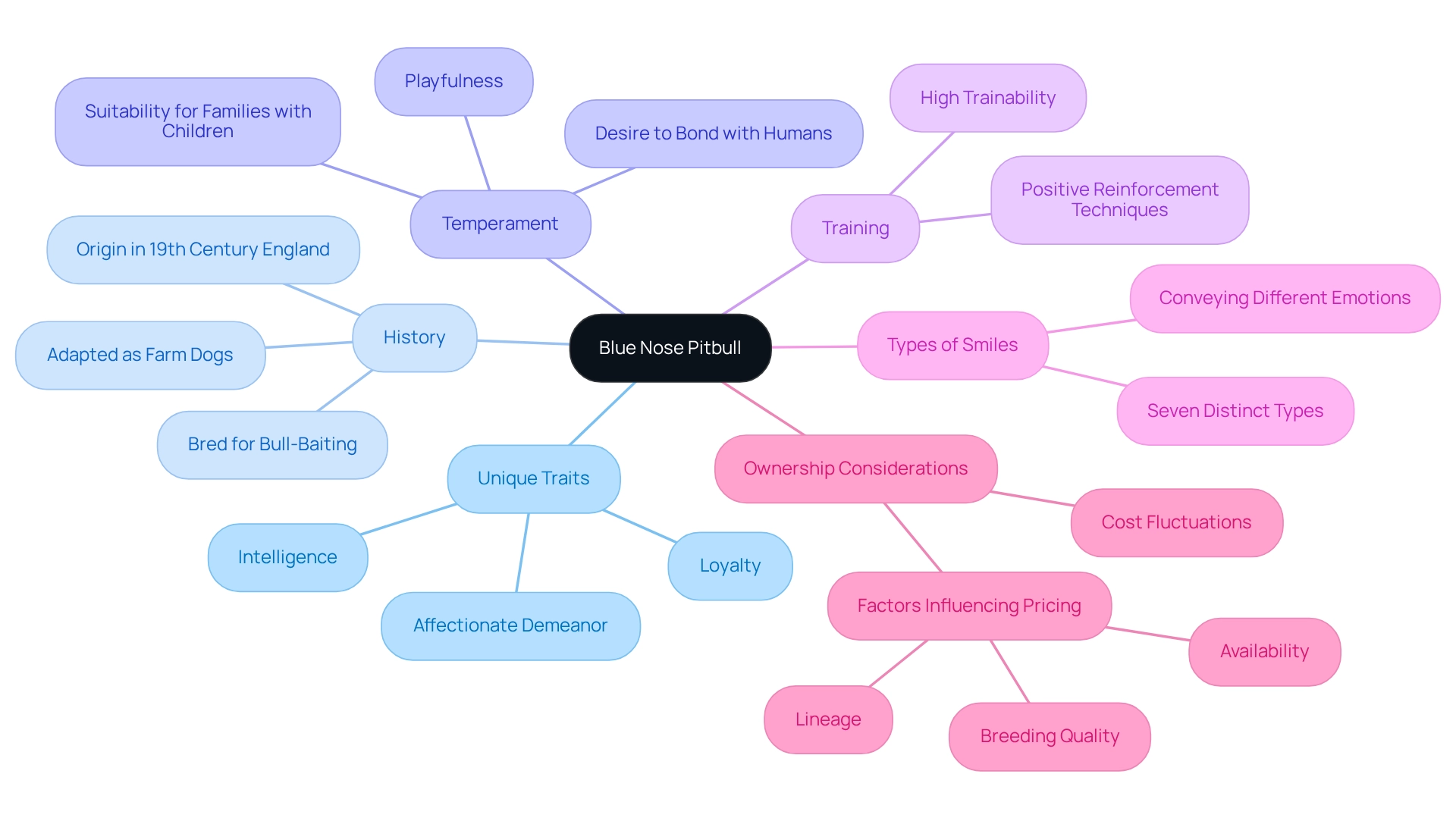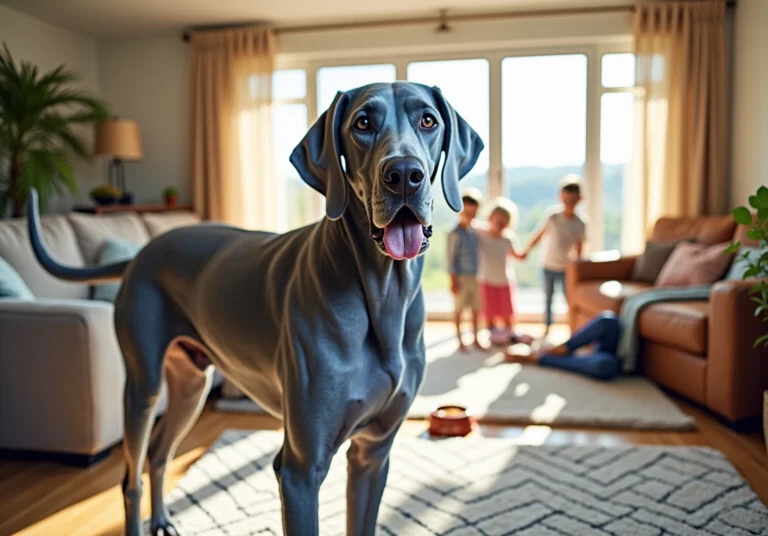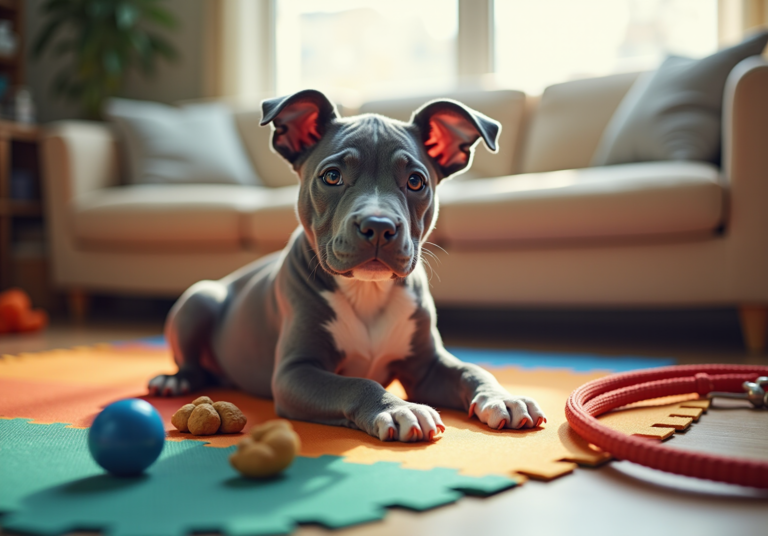Master Care and Training for Your Blue Nose Pitbull
Overview
This article is dedicated to providing comprehensive care and training strategies for your Blue Nose Pitbulls, emphasizing their unique traits and health considerations. We understand that as a pet owner, you want the best for your furry family members, and this guide is here to support you. By detailing effective care routines, training techniques, and common health issues, we aim to ensure that you can create a nurturing environment for your pets while addressing their specific needs.
At Adventure Den, we recognize the importance of understanding your pet’s individual requirements. With our compassionate approach, we offer solutions tailored to the unique challenges faced by Blue Nose Pitbulls. Our goal is to empower you with the knowledge and tools necessary for fostering a loving and supportive home.
Join us in this journey of care and connection, and together we can make a difference in the lives of your beloved pets.
Introduction
The Blue Nose Pitbull is not just a striking breed with its unique bluish-gray nose and coat; it also boasts a rich history and an endearing personality that captures the hearts of many. Originating from 19th-century England, this breed was initially bred for bull-baiting, but it has since evolved into a beloved family companion known for its loyalty, intelligence, and affectionate nature. With a playful temperament and a strong desire to bond with humans, Blue Nose Pitbulls truly thrive in family settings, making them excellent pets for households with children.
However, as you consider welcoming one of these remarkable dogs into your home, it’s essential to be well-informed about their specific care needs, training techniques, and common health issues. This knowledge will help ensure a fulfilling and harmonious relationship with your furry family member. As we explore the unique traits, effective care strategies, and health considerations of Blue Nose Pitbulls, you’ll gain valuable insights to support your journey as a responsible and loving pet owner. Remember, every step you take in understanding and caring for your pet contributes to a nurturing environment where both you and your Blue Nose Pitbull can flourish together.
Explore the Unique Traits and History of the Blue Nose Pitbull
The striking variation of the blue nose pitbull is easily recognized by its distinctive bluish-gray snout and coat, making it a beloved choice among pet owners. This breed has a rich history that traces back to 19th-century England, where it was initially bred for bull-baiting and later adapted as a versatile farm dog. Known for their loyalty, intelligence, and affectionate demeanor, blue nose pitbulls truly shine as exceptional family pets with their unique color pattern. Their temperament is characterized by playfulness and a strong desire to bond with their human companions, which makes blue nose pitbulls particularly well-suited for families with children.
Recent studies emphasize their trainability, with positive reinforcement methods yielding the best outcomes, as Pitbulls respond exceptionally well to this nurturing approach. Additionally, there are seven distinct types of Pitbull smiles, each conveying different emotions, further illustrating their communicative nature.
Understanding these traits allows you to foster a nurturing environment that meets your furry family member’s emotional and physical needs, ensuring a harmonious relationship between your dog and family members. Moreover, it’s important to be aware that the cost of Pitbulls can fluctuate depending on lineage, breeding quality, and availability—significant factors to contemplate when inviting this affectionate breed into your household. By considering these aspects, you can make an informed decision that brings joy and companionship into your life.

Implement Effective Care Strategies for Your Blue Nose Pitbull
To ensure your blue nose pitbull stays healthy and happy, consider these compassionate care strategies:
- Balanced Diet: Provide high-quality dog food that contains at least 25-30% protein, focusing on real meat, vegetables, and healthy fats. It’s important to avoid fillers like corn and soy, which can detract from their nutritional value. Additionally, ensure continual access to fresh, clean water, as this is essential for your Pit Bull’s overall well-being, particularly on a dry food diet. Healthy treats can include small pieces of fruits like apples or berries, vegetables like carrots or green beans, and lean meats; it’s best to steer clear of high-calorie commercial treats. A balanced diet is vital for sustaining their energy levels and general health.
- Regular exercise is essential, as blue nose pitbulls are energetic and require a minimum of 60-90 minutes of activity each day. Engage them in activities such as walks, runs, and playtime in a secure area to meet their physical needs and prevent behavioral issues. Experts emphasize that, due to their strong physique and high energy levels, any behavioral concerns should be addressed promptly to prevent them from becoming ingrained habits.
- Grooming: Brush your dog at least once a week to remove loose hair and distribute natural oils, keeping their coat healthy. Regular bathing, typically every month, helps maintain cleanliness and skin wellness.
- Routine Veterinary Care: Arrange consistent check-ups with a veterinarian to assess your dog’s condition and address any concerns swiftly. This proactive approach ensures that any potential health issues are caught early, contributing to a longer, healthier life.
By following these nurturing strategies, you can provide your furry family member with the care they need to thrive.
Apply Training Techniques for a Well-Behaved Blue Nose Pitbull
Training your blue nose pitbull can be a truly fulfilling journey when approached with the right techniques. Here are some effective strategies to consider that can help you nurture your furry family member:
- Positive Reinforcement: Reward your dog with treats, praise, and affection for good behavior. This method not only encourages them to repeat desired actions but also strengthens the bond between you and your pet. As Kathy Callahan, [a CPDT-KA and Family Dog Mediator, beautifully puts it, “The best training tip out there is so simple it likely slips your mind: catch your dog doing something right.”
- Consistency: Establish a regular training schedule and use the same commands for specific actions. Consistency is crucial, as it helps your dog understand expectations and fosters a sense of security, which is essential for effective learning. Statistics indicate that canines trained with consistent commands are more likely to respond accurately, improving their learning experience.
- Socialization: Introduce your dog to a variety of environments, people, and other animals from an early age. This exposure helps them become well-adjusted and reduces anxiety in unfamiliar situations, promoting a confident demeanor. Case studies have shown that well-socialized dogs exhibit better behavior and adaptability.
- Basic Commands: Focus on teaching essential commands such as ‘sit,’ ‘stay,’ and ‘come.’ Begin in a quiet setting to minimize distractions, gradually increasing complexity as your dog masters each command. The ideal emotional state for learning is described as a ‘safe emergency,’ which means creating an environment where your dog feels secure yet engaged, allowing for effective learning.
By employing these techniques, you can create a positive training experience for your blue nose pitbull that not only enhances its behavior but also strengthens the bond you share. Remember, every step you take in training is a step towards a loving and nurturing environment for your beloved pet.
Identify and Manage Common Health Issues in Blue Nose Pitbulls
Pitbulls with their unique appearance may face various health challenges that require attentive observation and preventive care. As a loving pet owner, it’s important to be aware of these common conditions and how to manage them effectively:
- Hip Dysplasia: This genetic condition can affect the hip joint, often leading to arthritis and chronic pain. Regular veterinary check-ups are essential, and maintaining a healthy weight can significantly alleviate symptoms. Studies show that early intervention and consistent exercise can enhance outcomes for affected canines. Providing about an hour of exercise daily can be beneficial in managing this condition, particularly for a blue nose pitbull, as they may be prone to skin allergies from food, pollen, or fleas, which can cause itching and skin irritation. It’s crucial to monitor your furry family member for these signs and consult your veterinarian for appropriate treatments. These may include dietary adjustments or allergy medications. Statistics reveal that skin allergies are among the most prevalent concerns in dogs, impacting roughly 10-15% of the canine population, underscoring the need for awareness and prompt action.
- Thyroid Issues: Hypothyroidism is another concern that can lead to weight gain and lethargy. Regular blood tests can help detect this condition early, allowing for timely treatment and management. Veterinary experts recommend routine screenings for early detection.
- Heart Disease: As your Pitbull ages, they may be at risk for heart disease. Regular veterinary examinations are vital for monitoring heart health, and pet owners should be vigilant for indicators like tiredness or trouble breathing. Keeping a close eye on these symptoms can lead to early detection and better management of heart-related issues.
- Supervision During Activities: Due to their distinctive body shape, Pitbulls with a blue coat may not be the best swimmers. It’s essential to supervise your pet near water and consider purchasing a life jacket if they enjoy swimming. This precaution is especially important for managing medical issues like hip dysplasia that may impact their mobility. By recognizing these common wellness issues and providing consistent veterinary care, owners of blue nose pitbulls can ensure their pets enjoy vibrant, joyful lives. Staying informed about the latest health issues in 2025 will further enhance the care provided to these beloved pets. Remember, your furry family members deserve the best, and together, we can create a nurturing environment for them.
Conclusion
The Blue Nose Pitbull is truly a remarkable breed, celebrated for its striking appearance and affectionate nature. Understanding their unique traits—loyalty, intelligence, and playfulness—is essential for any potential owner. These dogs thrive in family settings, making them excellent companions for households with children. By implementing proper care strategies such as a balanced diet, regular exercise, grooming, and routine veterinary visits, you can ensure your Blue Nose Pitbull leads a healthy and fulfilling life.
Training is another critical aspect of responsible ownership. By employing positive reinforcement, maintaining consistency, and encouraging socialization, you can significantly enhance the training experience. Basic command training fosters good behavior and strengthens the bond between you and your furry companion, leading to a harmonious relationship.
Awareness of common health issues—such as hip dysplasia, skin allergies, thyroid problems, and heart disease—is vital for maintaining the well-being of Blue Nose Pitbulls. Through diligent monitoring and proactive veterinary care, you can effectively address these health concerns, ensuring your beloved pet remains healthy and vibrant.
In conclusion, welcoming a Blue Nose Pitbull into your home is a journey filled with joy and responsibility. By committing to their care, training, and health needs, you can cultivate a nurturing environment where both you and your furry family member can thrive together. This breed’s affectionate nature and loyalty make them not just pets but cherished family members, enriching the lives of those fortunate enough to share their homes with them.
Frequently Asked Questions
What distinguishes the blue nose pitbull from other breeds?
The blue nose pitbull is easily recognized by its distinctive bluish-gray snout and coat, which makes it a beloved choice among pet owners.
What is the history of the blue nose pitbull?
This breed has a rich history that traces back to 19th-century England, where it was initially bred for bull-baiting and later adapted as a versatile farm dog.
What are the key traits of blue nose pitbulls?
Blue nose pitbulls are known for their loyalty, intelligence, and affectionate demeanor. They are characterized by playfulness and a strong desire to bond with their human companions.
Are blue nose pitbulls suitable for families with children?
Yes, blue nose pitbulls are particularly well-suited for families with children due to their affectionate nature and strong bonding desire.
How trainable are blue nose pitbulls?
Recent studies emphasize their trainability, with positive reinforcement methods yielding the best outcomes as they respond exceptionally well to nurturing approaches.
What is unique about the communication of blue nose pitbulls?
There are seven distinct types of Pitbull smiles, each conveying different emotions, which illustrates their communicative nature.
How can I create a nurturing environment for a blue nose pitbull?
Understanding their traits allows you to foster a nurturing environment that meets your furry family member’s emotional and physical needs, ensuring a harmonious relationship.
What factors influence the cost of blue nose pitbulls?
The cost of blue nose pitbulls can fluctuate depending on lineage, breeding quality, and availability, which are significant factors to consider when inviting this breed into your household.







